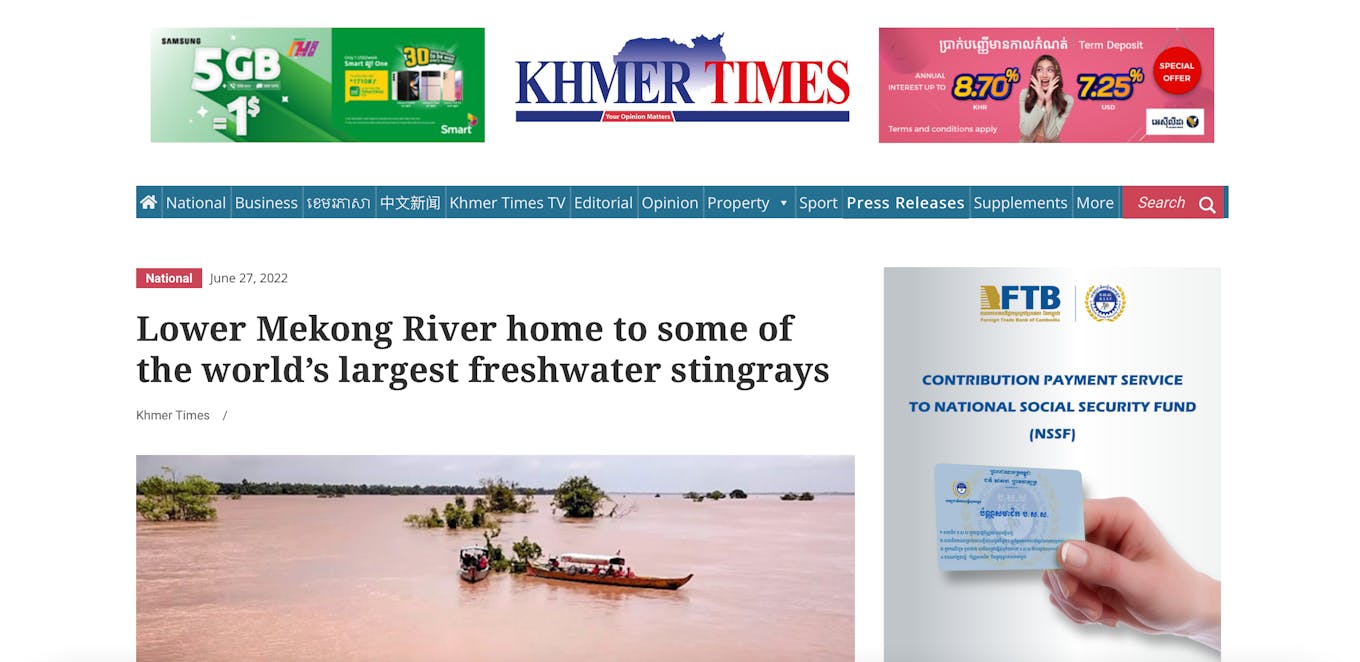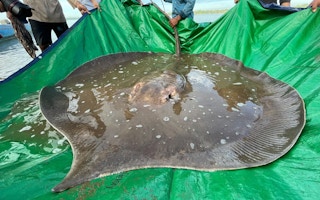Can a giant stingray in the Lower Mekong be used to craft a good narrative about Chinese upstream dams? It can, according to an unsigned Khmer Times article in June 2022 about a 300-kilogramme stingray found in Cambodia’s Stung Treng province. The article quoted Zeb Hogan, an American biologist and director of the Wonders of the Mekong project, as saying that “stingrays do not like to live in polluted waters”, and this “shows that China’s dam construction doesn’t affect the Lower Mekong’s ecosystem”. The project is funded by the United States Agency for International Development.
Republished on the website of the China-administered Lancang-Mekong Water Resources Cooperation Information Sharing Platform (LMC-ISP), this could have been an example of the “wonderful stories” the Chinese hope to tell to refute what they see as unfounded and US-instigated allegations about the negative environmental impact of dam building in the upstream Lancang (the Chinese name for the Mekong).
The stingray story, however, appears to have a sting in its tail. In reality, it is pure fabrication. Hogan confirmed via email with this author that he never spoke to the Khmer Times and he “did not say anything that was reported in the article”, adding that “it is clear that upstream dams do impact the lower Mekong River.” The article is a cautionary tale about China’s audacity in pushing dubious narratives about the Mekong water development.

This Khmer Times report that the Lancang-Mekong Cooperation republished on its website to tell the “wonderful story” about China’s upstream dams along the Mekong was found to have fabricated quotes.
An important vehicle for China’s discourse push is the Lancang-Mekong Cooperation (LMC) – a China-led subregional mechanism comprising all six Mekong riparian states (China, Cambodia, Laos, Myanmar, Vietnam and Thailand). “Wonderful stories” about China’s upstream dams in the Lancang have been promoted through China-administered LMC institutions such as the LMC Water Centre. This observation is based on content analysis of the LMC-ISP’s website run by the Centre. Established in 2020 as the LMC’s water-data sharing platform, the website seeks to promote China’s discourse on Mekong river governance.
The overall thrust of the website content denies the dams’ negative environmental consequences and amplifies their positive impact. The most common narrative is that Chinese upstream dams have provided regional public goods by “storing water in wet season and releasing water in dry season” for downstream states. This narrative of China’s benevolence and even altruism has been emphasised by Chinese leaders, experts and hydropower companies. According to the LMC Water Centre’s Secretary-General, Hao Zhao, China’s Jinghong dam “does not fully exert its function for domestic electricity demand, but tries its best to help the downstream to cope with possible droughts and avoid further transference of upstream challenges to the downstream.”
“
As with the stingray story, the Chinese narratives should be read with a pinch of salt. The trade-offs between hydropower and the river’s ecosystem have been extensively documented in various studies, including by the MRC, and an increasingly number of books and news reports about the plight of riparian communities due to drying flows and dwindling fish stocks.
To be fair, China did release water from Jinghong dam in March-April 2016 at Vietnam’s request to help alleviate the drought downstream. This was acknowledged by the Mekong River Commission (MRC) – a transboundary Mekong basin organisation constituting Cambodia, Laos, Thailand and Vietnam – on its website and in a 2019 joint study with the LMC Water Centre. However, this does not necessarily mean that altruism towards downstream states is the operative principle or consistent practice of Chinese dam operations. For example, using 1992-2019 satellite data and daily river height gauge data from Chiang Saen, Thailand, the April 2020 Eyes on Earth report highlighted the connection between the unprecedented drought during the wet season in the Lower Mekong in 2019 and Chinese upstream dams’ restriction of a large amount of water to prioritise hydropower sale to its domestic market that year. Furthermore, the one-dimensional emphasis on Chinese dams’ water-level moderation glosses over their adverse impact in other aspects, especially reduced replenishment of sediment from upstream and the resulting loss of fisheries and food security risks downstream, as highlighted by the MRC and expert studies.
The LMC-ISP website also shines the spotlight on climate change as the primary reason for the Mekong’s environmental woes, by featuring international reports on climate change and views by Chinese and Laotian experts and officials. A post titled “Laos Water Resources Experts: What Caused the Drought This Year” states that climate change-induced lower rainfall is the main cause of drought in the Mekong basin. The Laotian experts’ names are not specified and the original Vientiane Times article – purportedly republished in the post – cannot be found online. The same tactic of dubious reporting is observed in another post with similar content. Although the impact of climate change in the Mekong basin has been well documented, over-emphasis on this factor runs the risk of obscuring and even whitewashing the controversy over Mekong hydropower development.
Another tactic being employed to push positive messages has been that of “using international friends for international propaganda”, or co-opting the voices of foreigners in China’s discourse push. In the Mekong context, China has engaged foreign journalists in media campaigns to tell “wonderful stories” about Lancang-Mekong cooperation and China’s dam operations. Study tours, exchanges and visits to China have been organised under the LMC framework for downstream states’ officials, youth and media, setting the stage for their reported appreciation of China’s water governance. An August 2022 post on a visit to Lancang dams by Mekong diplomats and overseas students stated “their acknowledgement towards the importance of water infrastructures in mitigating droughts and floods”. The visit also reportedly deepened their “understanding of Chinese efforts to ecological and environmental protection while developing hydropower.”
Other more nuanced messages to boost the positive image of Lancang dams are embedded in stories about corporate social responsibility (CSR) of Chinese hydropower companies, especially those involved in downstream dam-building projects. These include, for example, Sanghe Secondary Hydropower Company with a rural water supply project in Cambodia and PowerChina Nam Ou River Basin Company’s “contribution to green development in Laos”.
As with the stingray story, the Chinese narratives should be read with a pinch of salt. The trade-offs between hydropower and the river’s ecosystem have been extensively documented in various studies, including by the MRC, and an increasing number of books and news reports about the plight of riparian communities due to drying flows and dwindling fish stocks. All Mekong riparian states face these trade-offs, and have a fair share of responsibility over the current state of the river. The cure to the dying Mekong, therefore, must begin with clinical analysis and honest exchange among riparian states. China’s unilaterally imposed narratives that obscure the full, complex picture of the situation is part of the problem, not the remedy.
Hoang Thi Ha is senior fellow and co-coordinator of the Regional Strategic and Political Studies Programme, ISEAS – Yusof Ishak Institute.
This article was first published by ISEAS – Yusof Ishak Institute as a Fulcrum commentary.











